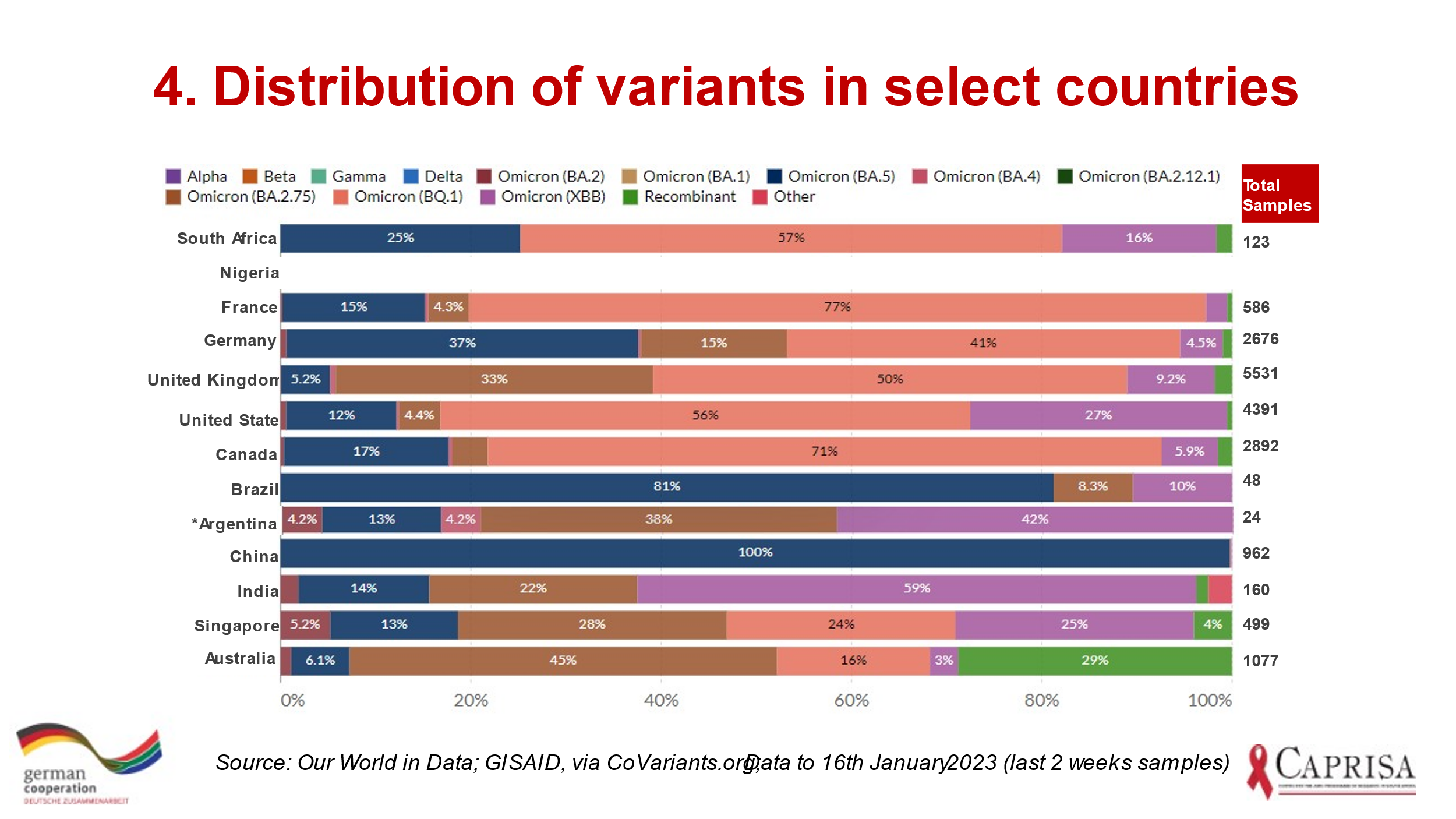Prof Salim Abdool Karim Weekly COVID-19 UPDATES
Thanks for all the valuable feedback on last week’s missive. Today’s is in a new format that was developed by the team here thanks to GIZ – it includes the images from the slides to make it easier to read. The slides have also been included in PowerPoint so that you can still use them as slides in your presentations if you wish.
So, let’s start with the global situation (Figure 1). Yesterday, there were about 214,000 confirmed cases and 1,800 deaths across the world. This is lower than last week’s cases and deaths.
Given the high number of cases in China, I had expected that the global decline in cases was being driven by the downslope of China’s omicron BA.5 wave. Well, the numbers tell a different tale. The global decline in cases is actually due to dropping numbers of new cases in the USA, Germany, France amongst others, but not due to China (Right side diagram in Figure 1). Most countries had runaway omicron waves, which were very hard to control with public health measures and vaccines resulting in prevalence rates of omicron infection as high as 80% in several countries. China’s experience is unlikely to be much different – a very large number of people have likely acquired omicron in the latest wave there. Looking at the figure below which shows the substantial omicron waves in the USA and Germany, I had expected to see a similar substantial wave in China, though about a year later than the rest of the world – I would be surprised if China did not have a substantial omicron wave given it is almost impossible to escape its high transmissibility.

China’s decision not to be transparent about its cases and deaths has created a situation where the data in the last few months do not accurately reflect the global situation. In Figure 2 below, I have provided the 5 small countries (population < 20 million) and the 5 large countries (population > 20 million) that are the biggest contributors to new cases over the last 7 days. Note that the colour code on the number indicates the incidence rate ie. those that are yellow are large increases off a low base while red indicates both large numbers of confirmed cases and high incidence rates. Japan, Taiwan and South Korea have both rising numbers of cases and high incidence rates.

South Africa remains in low transmission, though small outbreaks are continuing to occur (Figure 3). These localised transmissions are resulting in small increases in cases. Deaths have also increased slightly, though off a low base.

In those parts of the world where cases are going up, it would be useful to get some idea of which variants are driving the increases. In particular, whether there is a variant that is rapidly becoming dominant – just as XBB.1.5 has demonstrated in the USA. Figure 4 below provides just a snapshot from Our World in Data on the latest distribution of variants in 2 selected countries from each continent/region. This diagram is an interim attempt to pictorially represent the frequency distribution of variants sequenced in the last 2 weeks – Marothi is working on refining this. At this time, 3 omicron variants are the most common being transmitted, based on this set of samples – BA.5, BQ.1 and XBB, with XBB growing fastest. Note that a blank line, which we have for Nigeria in Figure 4, means that the country uploaded no new SARS-CoV-2 sequences on GISAID in the previous 2 weeks.

That was a quick snapshot of the global Covid-19 situation.
To provide some “relief” from Covid-19, I am going to occasionally cover other significant epidemics just as a reminder that we live in world where the spread of SARS-CoV-2 is not our only concern. Today, I thought I would touch briefly on cholera. Cholera has been spreading over the last few months in several countries in multiple continents (Figure 5).

Cholera also takes advantage of situations of adversity since it is spread by the faeco-oral route where clean water supplies are often lacking. Such a situation of adversity exists right now is Haiti. With high levels of political instability, rampant gangsterism and failing infrastructure, it is proving to be a good breeding ground for cholera. In the last 3 months of 2022, cholera has become widespread across all provinces of Haiti (Figure 6). This is putting yet more pressure on the struggling health care services in that country.

Across the ocean from Haiti, Malawi has been similarly experiencing a rapidly growing cholera epidemic (Figure 7). While cholera has not reached pandemic status, current trends do not bode well and we need to keep an eye on this situation and provide international support to affected countries as this bacterium hits poor countries that lack good sanitation and clean water supply.

The interventions to bring cholera are well known and have previously been used very effectively to control cholera outbreaks in South Africa. High priority is early rehydration for new cases. Once patients develop “rice water” stools, hydration is critical and cholera deaths are readily preventable. Antibiotics are indicated in severe cases. Since many of us have not seen cholera in a while, I am including below the WHO cholera toolkit poster that shows what combination of interventions are needed to deal effectively with cholera.



